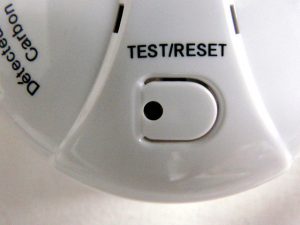Carbon Monoxide Poisoning in Michigan

Carbon monoxide detectors can save lives. Michigan law requires one in every single family home, and one in each unit of multi-family dwellings. (Flickr / Creative Commons / Judy van der Velden)
Yesterday we wrote a blog about a couple and their dog that were exposed to high levels of carbon monoxide in a Warren, MI hotel. They were rescued from their room. They are now in stable condition. The hotel was evacuated.
It is unclear what their carboxyhemoglobin levels were. It is also unclear whether or not they were given hyperbaric oxygen treatment or normobaric oxygen treatment. As stated yesterday, hyperbaric oxygen treatment is much more effective in reducing the after-effects of carbon monoxide poisoning.
This wasn’t the only carbon monoxide poisoning that happened in Michigan recently. Over the weekend, a Southfield, MI apartment building filled with carbon monoxide from a faulty water heater, according to Fox 2. Two Mormon missionaries were the only ones with carbon monoxide detectors in the building.
They called 911 and started knocking on doors to try to save the lives of other people without carbon monoxide detectors. When firefighters came, they evacuated the building, saving about 20 people who started feeling sick. The carbon monoxide levels were dangerously high at about 100 parts per million.
Apartment managers now say they are installing carbon monoxide detectors in every room of the building. Michigan law requires a carbon monoxide detector within each unit of a multifamily dwelling as well as at least one within a single-family dwelling. It is very likely that the two women saved the lives of many people that day.
Carbon monoxide kills an estimated 3700 people annually in the United States, writes Neil B. Hampson in Carbon Monoxide Toxicity (2000). It’s the leading cause of poisoning death in the United States. Nonfatal poisoning is more likely to occur with about 40,000 people seeking medical attention each year.
Carbon monoxide poisonings are much more common in winter than summer, because the heat is turned on. In the Warren, MI hotel poisoning, it is unclear why the heat was turned on in summer. In the Southfield, MI apartment building, the source was a hot water heater. However, the most common source of carbon monoxide resulting in unintentional death was motor vehicle exhaust. In non vehicular poisonings, the most common location is a residential setting, such as a home or garage.
Treatment of carbon monoxide poisoning involves removing the person from the toxic area and providing oxygen treatment. More serious carbon monoxide poisoning can result in brain damage as a result of the brain being deprived of oxygen and failure to exhaust toxic materials.